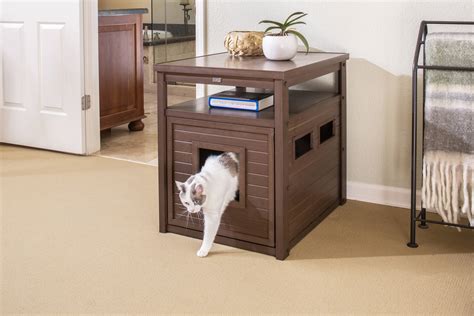In the world of cat ownership, litter box issues can be a major source of frustration. One common problem is litter box aversion, where cats avoid using their designated toilet due to various factors. Litter box concealment and hiding can be effective solutions to address this issue, providing privacy, reducing stress, and promoting overall feline well-being.

Why Conceal or Hide a Litter Box?
According to the American Veterinary Medical Association (AVMA), approximately 10% of cats exhibit litter box aversion. This can lead to inappropriate elimination, which can be a nuisance for cat owners and create challenges for maintaining a clean and healthy living environment.
Concealing or hiding a litter box offers several benefits:
- Increased privacy: Cats naturally seek privacy when using a bathroom. A concealed or hidden litter box provides a more secure and comfortable space for them to do their business.
- Reduced stress: Litter box aversion can often be caused by stress, such as fear of being startled or having a negative experience while using the litter box. Concealment can help reduce stress and make cats feel safer.
- Improved hygiene: A hidden litter box can minimize the spread of litter and odor, reducing the need for frequent cleaning and helping maintain a cleaner living space.
Creative Concealment Ideas
There are numerous ways to conceal or hide a litter box, depending on your home layout, budget, and cat’s preferences:
- Under a cabinet: Place the litter box under a cabinet with a cut-out entrance.
- Inside a bookshelf: Fit a litter box into a vacant space on a bookshelf, with a curtain or drawer to conceal it.
- Under a side table: Create a discreet area under a side table with curtains or a fabric cover.
- In a closet: Use a closet with a litter box mat and odor-absorbing products.
- Inside a pet furniture: Purchase pet furniture specifically designed to house litter boxes, with concealed compartments and ventilation.
Pros and Cons of Hiding Litter Boxes
Pros:
- Reduces stress and litter box aversion
- Improves privacy and security for cats
- Enhances home aesthetics
- Controls odor and litter spread
Cons:
- May not be suitable for all cats
- Can be challenging to clean
- May require additional space
Effective Strategies for Litter Box Hiding
- Choose a convenient location: Make sure the litter box is easily accessible for your cat but not in a high-traffic area.
- Provide multiple boxes: Offer two or more litter boxes to give your cat options, especially if they have multiple elimination areas.
- Experiment with different types of litter: Some cats prefer finer litter, while others may prefer larger granules. Try different types to find what your cat likes best.
- Keep litter boxes clean: Scoop and change litter regularly to prevent odor and bacteria buildup.
- Use an odor control system: Charcoal filters, air purifiers, and baking soda can help absorb litter box odors.
FAQs about Litter Box Concealment and Hiding
1. Is it necessary to hide a litter box?
Not all cats require a concealed or hidden litter box, but it can be beneficial for cats with litter box aversion or in households with multiple cats or pets.
2. How can I transition my cat to a concealed litter box?
Start by placing a treat or a small amount of food near the hidden litter box. Gradually move the treat further into the box until your cat is comfortable using it.
3. My cat refuses to use the concealed litter box. What should I do?
Ensure the location is suitable, the litter box is clean, and the litter type is appropriate. If your cat still refuses, consult a veterinarian to rule out any underlying medical issues.
4. How often should I clean a concealed litter box?
Scoop solid waste daily and change the litter completely every 1-2 weeks, depending on the number of cats and litter usage.
5. What if my cat starts eliminating outside the litter box?
Identify and address any potential stressors or medical issues. Clean the areas where your cat has eliminated outside the box thoroughly and use enzymatic cleaners to remove any lingering odors.
6. Do all cats prefer hidden litter boxes?
Some cats may prefer open litter boxes or boxes with a clear view of their surroundings. Observe your cat’s behavior and preferences to determine what works best for them.
Current Status and Future Directions
The concept of litter box concealment and hiding has been gaining traction in recent years, with more cat owners seeking solutions to manage litter box aversion and improve feline well-being. As technology advances, innovative products and solutions are emerging to enhance litter box hygiene, odor control, and privacy for cats.





















